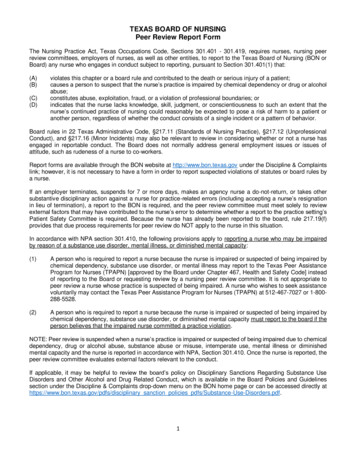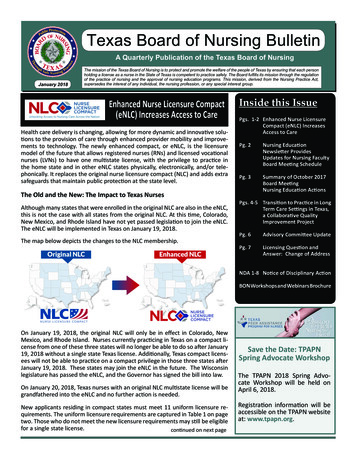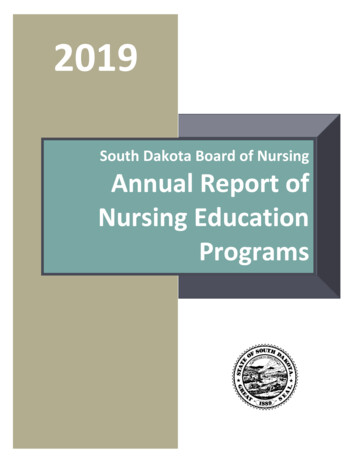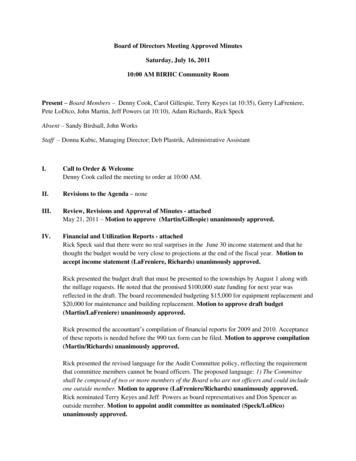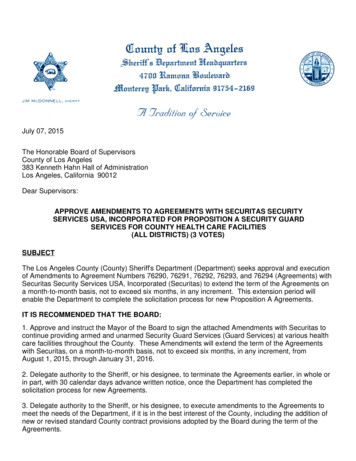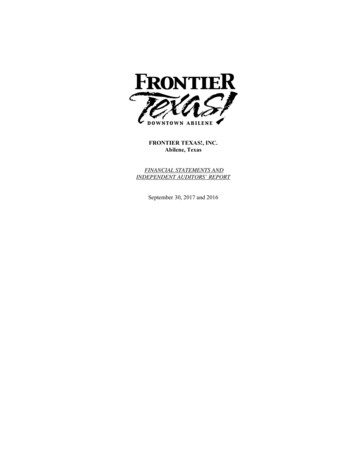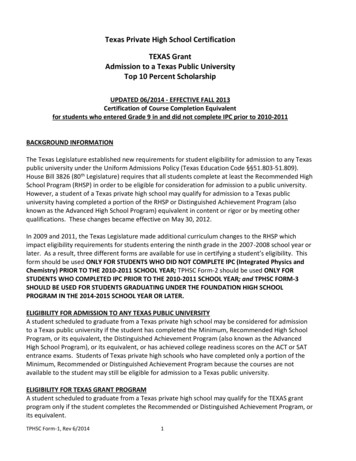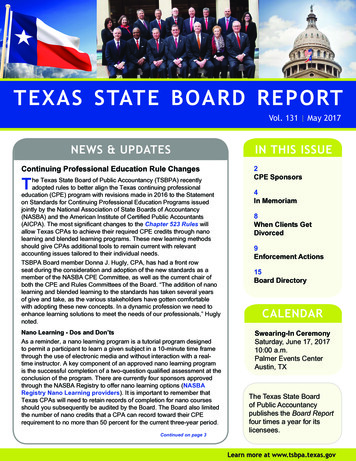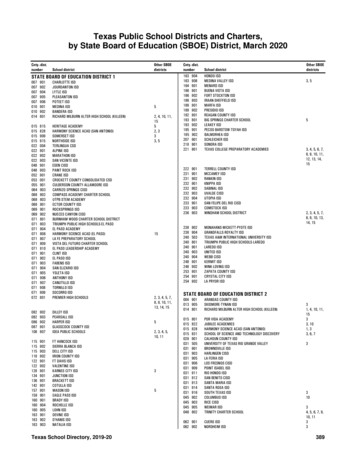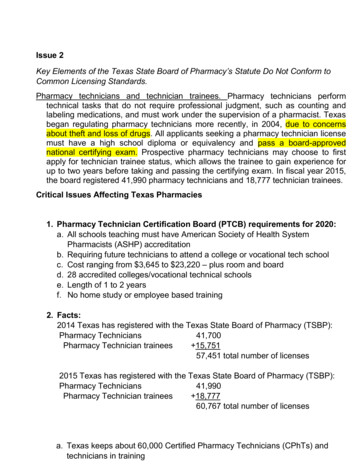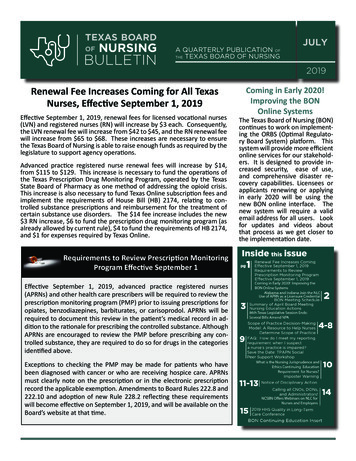
Transcription
TEXAS BOARDOFNURSINGBULLETINA QUARTERLY PUBLICATION OFTHE TEXAS BOARD OF NURSINGRenewal Fee Increases Coming for All TexasNurses, Effective September 1, 2019Effective September 1, 2019, renewal fees for licensed vocational nurses(LVN) and registered nurses (RN) will increase by 3 each. Consequently,the LVN renewal fee will increase from 42 to 45, and the RN renewal feewill increase from 65 to 68. These increases are necessary to ensurethe Texas Board of Nursing is able to raise enough funds as required by thelegislature to support agency operations.Advanced practice registered nurse renewal fees will increase by 14,from 115 to 129. This increase is necessary to fund the operations ofthe Texas Prescription Drug Monitoring Program, operated by the TexasState Board of Pharmacy as one method of addressing the opioid crisis.This increase is also necessary to fund Texas Online subscription fees andimplement the requirements of House Bill (HB) 2174, relating to controlled substance prescriptions and reimbursement for the treatment ofcertain substance use disorders. The 14 fee increase includes the new 3 RN increase, 6 to fund the prescription drug monitoring program (asalready allowed by current rule), 4 to fund the requirements of HB 2174,and 1 for expenses required by Texas Online.Requirements to Review Prescription MonitoringProgram Effective September 1Effective September 1, 2019, advanced practice registered nurses(APRNs) and other health care prescribers will be required to review theprescription monitoring program (PMP) prior to issuing prescriptions foropiates, benzodiazepines, barbiturates, or carisoprodol. APRNs will berequired to document this review in the patient’s medical record in addition to the rationale for prescribing the controlled substance. AlthoughAPRNs are encouraged to review the PMP before prescribing any controlled substance, they are required to do so for drugs in the categoriesidentified above.Exceptions to checking the PMP may be made for patients who havebeen diagnosed with cancer or who are receiving hospice care. APRNsmust clearly note on the prescription or in the electronic prescriptionrecord the applicable exemption. Amendments to Board Rules 222.8 and222.10 and adoption of new Rule 228.2 reflecting these requirementswill become effective on September 1, 2019, and will be available on theBoard’s website at that time.JULY2019Coming in Early 2020!Improving the BONOnline SystemsThe Texas Board of Nursing (BON)continues to work on implementing the ORBS (Optimal Regulatory Board System) platform. Thissystem will provide more efficientonline services for our stakeholders. It is designed to provide increased security, ease of use,and comprehensive disaster recovery capabilities. Licensees orapplicants renewing or applyingin early 2020 will be using thenew BON online interface. Thenew systemJuly will require a validemail address for all users. Lookfor updates and videos aboutthat process as we get closer tothe implementation date.
Alabama and Indiana Join the Nurse Licensure CompactThe Alabama Governor hassigned Senate Bill (SB) 38,which enacts the NurseLicensure Compact (NLC)in Alabama. The AlabamaBoard of Nursing anticipates an implementationdate of January 1, 2020.The Texas Boardof NursingBOARD MEMBERSOfficersKathleen Shipp, MSN, RN, FNPPresident, representing AdvancedPractice NursingLubbockThe Indiana Governor hassigned House Bill 1344,which enacts the NLC in Indiana. The bill becomes effective July 1, 2019, but theimplementation date is yetto be determined.David Saucedo, II, BAVice-President, representing ConsumersEl PasoMembersNina Almasy, DNP, MSN, RN, CNErepresenting LVN EducationAustinLouisiana became the 31st state in the nation to enact the NLC on May 31,2018, when Governor John Bel Edwards signed SB 202 into law. Louisiana andKansas both implemented the NLC on July 1, 2019.New Jersey is one step closer to joining the NLC, as the NLC bill has passed thelegislature and is awaiting the Governor's signature. New Jersey will bring thetotal compact membership to 34 states.Use of APRN as a Licensure CredentialTexas Board of Nursing (Board) Rules were recently amended to provide clarification to advanced practice registered nurses (APRNs) regarding the use of credentials. Board Rule 221.2(b) clarifies that APRNs are now required to identifythemselves as APRNs and also identify the licensure title they are authorized touse by the Board. This means that, at a minimum, an APRN must list credentialsas both an APRN and identify the title authorized by the Board. For example,a family nurse practitioner must use both APRN and FNP, or a nurse-midwifemust use APRN, NM. Please note that the Board does not specify the order inwhich credentials must appear. It is acceptable to place either credential firstas long as both credentials are included.The Board does not require the inclusion of academic distinctions or certification designations when listing credentials. If you wish to use these additionalcredentials, you may do so. If you are in a facility-based practice or in an employment setting where there are policies regarding the use of these additionalcredentials, we recommend you review the policies for your practice setting.Texas Board of Nursing Meeting Schedule2019 Board Meeting DatesJuly 25-26October 24-252019 Eligibility and DisciplinaryCommittee Meeting DatesAugust 13November 12September 10December 10All Board and Eligibility& Disciplinary Committee Meetings will be heldin Austin at the WilliamP. Hobby Building located at 333 Guadalupe,Austin, Texas, 78701.2Patricia "Patti" Clapp, BArepresenting ConsumersDallasLaura Disque, MN, RNrepresenting RN PracticeEdinburgAllison Porter-Edwards, DrPH, MS, RN, CNErepresenting BSN EducationBellaireDiana Flores, MN, RNrepresenting RN PracticeHelotesDoris Jackson, DHA, MSN, RNrepresenting ADN EducationPearlandMazie M. Jamison, BA, MArepresenting ConsumersDallasKathy Leader-Horn, LVNrepresenting LVN PracticeGranburyMelissa D. Schat, LVNrepresenting LVN PracticeGranburyFrancis Stokes, BArepresenting ConsumersPort AransasKimberly L. "Kim” Wright, LVNrepresenting LVN PracticeBig SpringExecutive DirectorKatherine A. Thomas, MN, RN, FAANThe Texas Board of Nursing Bulletin is theofficial publication of the Texas Board ofNursing and is published four times ayear: January, April, July, and October.Subscription price for residents withinthe continental U.S. is 15.00, plus tax.Published by:TEXAS BOARD OF NURSINGVOLUME L - No. IIIPublication Office:333 Guadalupe, Suite 3-460Austin, Texas 78701-3944Phone: (512) 305-7400Fax: (512) 305-7401Publication Date: 06/15/2019
Summary of ActionsA regular meeting of the Board of Nursing was held April 25-26 2019, in Austin.The following is a summary of Board actions taken during this meeting.In the April 12, 2019, edition of theTexas Register:The Texas Board of Nursing (Board)published as adopted amendmentsto §213.33(b) and (e), relating toFactors Considered for Impositionof Penalties/Sanctions. The amendments were adopted with changes tothe proposed text as published in theFebruary 15, 2019, issue of the TexasRegister (44 TexReg 665). The TexasLegislature adopted House Bill (HB)2950 during the 85th Regular Legislative Session. HB 2950 amended theOccupations Code §301.461 (NursingPractice Act) to prohibit the Boardfrom imposing upon an applicant orlicensee the costs of an administrativehearing at the State Office of Admin-istrative Hearings (SOAH). The proposed amendments are necessaryto conform to this statutory requirement. The proposed amendmentsalso eliminate redundant languagefrom the section and clarify the use ofthe Board’s Disciplinary Matrix. Thedate of adoption for amendments to§213.33(b) and (e) was April 21, 2019.Nursing Education Actions - April 2019 Board MeetingReviewed Reports on:Education Programs in Lufkin.New Nursing Education Programsand Currently Active and PotentialProposals; Programs with Sanctions;Communication Activities withNursing Education Programs; 2018NCLEX-PN Examination Pass Rates;NCLEX Examination Statistics; andClosed Vocational and ProfessionalNursing Education Programs since2006.Approved Change in Approval Statusfrom Initial Approval to Full Approval:Tarrant County College – VN EducationProgram in Fort Worth.Approved Change in Approval Statusfrom Full Approval with Warning toFull Approval:Approved Report of Survey Visit:Clarendon College – VN EducationProgram in Pampa and Kilgore College– VN Education Program in Longview.Angelina College – Vocational Nursing (VN) (MEEP and Traditional) andAssociate Degree Nursing (ADN)Reviewed Reports of Approval of NewBaccalaureate Degree Nursing (BSN)Education Programs in Public JuniorColleges:Collin College in McKinney, LaredoCommunity College in Laredo, andSouth Texas College in McAllen.Approved Proposal to Establish aNew Nursing Education Program:Chamberlain College of Nursing– BSN Education Program in SanAntonio.Approved Continuation of Conditional Approval Status:CyberTex Institute of Technology –VN Education Program in Austin.86th Texas Legislative Session Ends: Several Bills Amend Nursing Practice ActOn June 10, 2019, Governor GregAbbott signed two bills amendingthe Nursing Practice Act.House Bill (HB) 2059, by CesarBlanco, relating to required human trafficking prevention trainingfor health care practitioners andcertain employees of health carefacilities, requires a nurse who provides direct patient care to complete a human trafficking prevention course approved by the Healthand Human Services Commission(HHSC). The HHSC is required to develop at least one human traffickingprevention course that is availablewithout charge, and post a list ofthe approved training courses onHHSC's Internet website. Currently, Board staff are looking at changes to Chapter 216 of the Board ofNursing Rules and Regulations relating to Continuing Competencynecessary to implement the newrequirements added by HB 2059and other bills enacted by the 86thTexas Legislature.view committee determination byorally notifying the nurse's supervisor of the request.HB 2059 and HB 2410 become effective September 1, 2019. To viewthe text of these bills, visit: https://capitol.texas.gov/ For additionalinformation, see the Legislative Update (Agenda Item 1.3) for the July2019 Board Meeting, which canHB 2410, by Stephanie Klick, relat- be found at www.bon.texas.gov/ing to a request for a nursing peer meetings board meetings.asp.review determination, authorizes anurse, if the nurse is unable to com- The October 2019 issue of the BONplete a Safe Harbor Request Form Bulletin will also include a summarydue to immediate patient care of legislation enacted by the 86thneeds, to request a nursing peer re- Texas Legislature.3
Scope of Practice Decision-Making Model: A Resource to HelpNurses Determine Scope of PracticeBy Heather Franz, MSN, APRN, AGCNS-BCMany nurses contact the TexasBoard of Nursing (BON or Board)with questions about whether ornot specific activities or proceduresare within their scope of practice.In response to scope-related questions, Board staff are rarely ableto give simple yes or no answers.This is because every situation isdifferent with many variables toconsider. Along with legal scopeof practice and standard of careconsiderations, nurses must alsoreflect upon their individual background, knowledge, skills, and levelof competence relating to a particular activity, procedure, or role.Recognizing that there is much toconsider, the Board developed aresource to assist nurses in makingsound scope of practice decisions.Nursing is a dynamic, ever-changing practice, and for this reason,the Board does not have a list of activities or procedures that all nursescan or cannot do. Formal educationin nursing prepares nurses withthe foundational competencies topractice nursing at either the vocational or professional level. Uponcompleting their nursing educationand obtaining licensure, nurses entering the workforce may practicein a variety of roles and healthcaresettings and will achieve and maintain competence in activities, interventions, or procedures relevant totheir current area of practice. Asnurses advance throughout theircareers they may encounter newactivities, procedures, or areas ofnursing practice that require additional education and training toachieve a level of competence thatensures patient safety. Accordingly,each nurse’s experience and levelof competence related to a particular area of nursing practice, activity,or procedure is different. It cannotbe presumed that what one nursecan do, e.g., insertion/removal of aperipherally inserted central catheter (PICC line) or review of an electronic fetal monitoring strip, can bedone by any nurse at any point inhis/her nursing career.It is important for each nurse to beaware of and recognize when he/she reaches the limits of his/herscope. If a nurse accepts an assignment to, for example, insert/removea PICC line or review an electronicfetal monitoring strip, he/she is individually accountable for carryingit out competently and safely, alongwith functioning within the parameters of the legal scope of nursingpractice. Likewise, if a nurse doesnot feel appropriately prepared tocarry out an assignment, he/sheis responsible for speaking up tosupervisors to request instructionand supervision, while also makinga reasonable effort to obtain thenecessary training, knowledge, andskills to competently carry out theassignment in the future.Beyond competence, determininga nurse’s legal scope of practicerelated to a specific activity or procedure can be challenging becausethe Nursing Practice Act (NPA) andBoard rules are written broadly. Legal scope of practice or the nurse’slegal authorization to practice nursing is based on licensure level, i.e,licensed vocational nurse (LVN) orregistered nurse (RN), and whatconstitutes the practice of nursingat the vocational or professionallevel. Each nurse must ensure he/4she is functioning within the legalparameters of nursing practice athis/her licensure level, bearing inmind that he/she practices underhis/her own license and is accountable for providing safe, effectivecare in accordance with the standards of nursing practice. In addition, the nurse should reflect uponwhether or not he/she can upholdthe standards of safe nursing practice outlined in Board Rule 217.11when performing a particular activity/procedure.The Board addresses specific questions or situations in position statements, which are available on theBON’s website. Position statementsdo not have the force of law, butthey provide guidance regardingthe Board’s opinion on an issue. Acommon thread throughout theposition statements is the emphasison a nurse’s legal duty to promotepatient safety. In some instances,other regulatory agencies have applicable rules and regulations toconsider when determining scopeof practice. To comply with Boardrules, nurses must know and followall the laws and rules at the local,state, and federal levels applicable to their current area of nursingpractice.Typically, a facility or employmentsetting will have policies and procedures to guide specific nursingprocedures or activities. The policies and procedures may addressaspects of a nursing procedure,such as required training, competency assessment and interval for“recertifying” competency, whosupervises and “signs off”, instructions for the procedure, actions tocontinued on next page
Scope of Practice - continued from previous pagetake in the event of complications/untoward events, etc. The BON hasno jurisdiction over facility policies,but policies and procedures areimportant for nurses to know andreference, as they are developed tohelp nurses and the facility at largecomply with the applicable regulations and accreditation standards.Board staff recognizes that policiesand procedures may not be available for every situation or may beoutdated. In these instances, nurses are encouraged to seek guidancefrom their nursing supervisors andnursing administrators. The nurseand his/her administrators mayconsider working together to develop or revise policies and procedures.In the best interest of patients andto ensure sound decision-makingand quality nursing care, nursesshould stay informed about currentevidence-based practice standardsor guidelines applicable to theirarea of practice. Evidence-basedpractice guidelines and/or national nursing organizations can helpnurses determine the best practicesand standards in a particular areaof nursing practice. Also, nationalnursing organizations may specifywhich qualifications or certification(s) are necessary for a nurse toperform a particular role, activity,or procedure.source, but recently a major revisionwas done to provide more clarity fornurses. In developing the newest resource, Board staff reviewed scopeof practice-related resources fromover 20 boards of nursing across thenation, as well as the National Council of State Boards of Nursing Scopeof Practice Decision-Making Framework. The new resource tool is titledthe Scope of Practice Decision-Making Model, which will be referred toas the DMM for short.Example 1: You are a RN withseveral years of ICU experience.You are often the go-to person onyour unit for difficult peripheral IVinsertions and have provided IVtherapy to numerous patients viaPICC line, amongst other centralvenous access devices. You haverecently been offered a positionon the PICC team at your hospital and want to know if insertinga PICC line would be within yourscope of practice.The DMM contains eight questionsto assist nurses in making a soundscope of practice decision. The DMMis meant to be answered in a stepwise fashion, beginning at the topand continuing through each question in order. If a nurse is able to progress through all questions withoutreaching a stop sign, he/she may proceed with the activity or procedurein question. Conversely, if at any timea nurse reaches a stop sign, he/sheshould consider the activity or intervention to be beyond his/her scopeof practice. The DMM also includestwo pages of supplemental information that guides nurses to resourcesor other considerations to explorefor each question in the model.1. Is this activity or intervention prohibited by the Texas NPA;Board rules, guidelines, or position statements; or any law, rule,or regulation from any agency?Review the Standards of NursingPractice outlined in Board Rule217.11. The nurse should reflecton his/her duty to keep patientssafe and uphold all of the standards of nursing practice.Relevant BON Position Statements to consider: Position Statement 15.10(Continuing Education Limitationsfor Expanding Scope of Practice)examines how continuing educaThe DMM can be found on thetion, certification, or on-the-jobBoard’s website within the Practicetraining can serve to maintain,tab by selecting Scope-Vocationaldevelop, and expand competenNurse Practice or Scope-Registeredcy, but each nurse must realizeNurse Practice and scrolling to thethe licensure-level limitations toblue hyperlink labeled Scope of PracIn response to scope-related inqui- tice Decision-Making Model. Hyper- expansion of his/her scope. Conries, Board staff have previously links to the DMM are also embedded tinuing education or on-the-jobreferred nurses to the Six-Step De- in various position statements and training cannot be substituted forformal education leading to thecision-Making Model, a resource FAQs on the BON’s website.next level of nursing practice/lideveloped in 1994 by the Boardto help nurses individually make The following are two examples that censure.sound judgements about perform- demonstrate how to use the DMM toing specific nursing activities or make a scope of practice determina- Position Statement 15.14(Duty of a Nurse in Any Practiceprocedures. Over time, minor re- tion.Setting) discusses that a nurse’svisions have been made to the re5continued on next page
Scope of Practice - continued from previous pageduty in any prac
The Texas Board of Nursing Bulletin is the official publication of the Texas Board of Nursing and is published four times a year: January, April, July, and October. Subscription price for residents within the continental U.S. is 15.00, plus tax. Published by: TEXAS BOARD OF NURSING VOLUME L - No. III Publication Office: 333 Guadalupe, Suite 3-460
